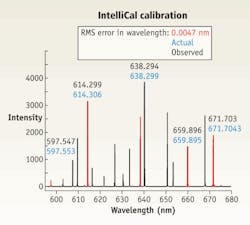SPECTROSCOPY: New calibration routine promises unprecedented accuracy
How accurate is your spectroscopy data? If only you really knew.
Traditional spectrograph calibration methods rely on a few mercury emission lines, and achieving calibration involves choosing two points in a spectrum and fitting a function between them. The problem with this approach is twofold: Any point outside the boundaries is not calibrated–and what's more, you have no information about the accuracy of any point in between. "You can guess, but you don't know for sure," says Ed Gooding, Ph.D., spectroscopy product manager at Princeton Instruments (Trenton, NJ).
Gooding's colleague, Senior Scientist Jason McClure, Ph.D, adds that, "One's knowledge of how well a spectrograph may be calibrated is correlated to how well the location of any known emission line may be determined." He says, "This will obviously improve with the groove density of the grating selected. However, one can also improve the accuracy of the calibration by employing a more sophisticated calibration procedure in the first place."
A more sophisticated approach is just what Princeton was after when it devised a new routine able to refine spectrograph parameters to match observed and calculated emission spectra in intensity space. Gooding says the result is an order of magnitude increase in wavelength accuracy, and a substantial reduction in the need for user input.
The routine reports the root-mean-square (RMS) wavelength error at each point, and stores the calibration information in the file header. "The software will tell you wavelength accuracy for every pixel in an array, or equivalently, at every point on a spectrum," explains Gooding. Once a spectrograph has been calibrated, a one-click search-match algorithm identifies the current center wavelength position without the need for a new refinement cycle. The system incorporates NIST spectral tables.
Data validation is the value proposition for instrument makers, analytical chemists, and life scientists. "Calibration of spectrographs are extremely important for both the beginner (student) and senior researcher doing spectroscopy," says Prof. Robert R. Alfano, director of the Institute for Ultrafast Spectroscopy and Lasers, The City College of New York. "To have a convenient and accurate way to calibrate as the IntelliCal does would make for better data."
Princeton is seeking a patent on the technology. The routine, called IntelliCal, is available as an add-on for the company's new 64-bit data acquisition software package, called LightField. A USB-powered dual light source using switchable Hg and Ar/Ne sources provides the emission lines that are used in the calibration. The source is bundled with IntelliCal and will also be available separately.

Barbara Gefvert | Editor-in-Chief, BioOptics World (2008-2020)
Barbara G. Gefvert has been a science and technology editor and writer since 1987, and served as editor in chief on multiple publications, including Sensors magazine for nearly a decade.
